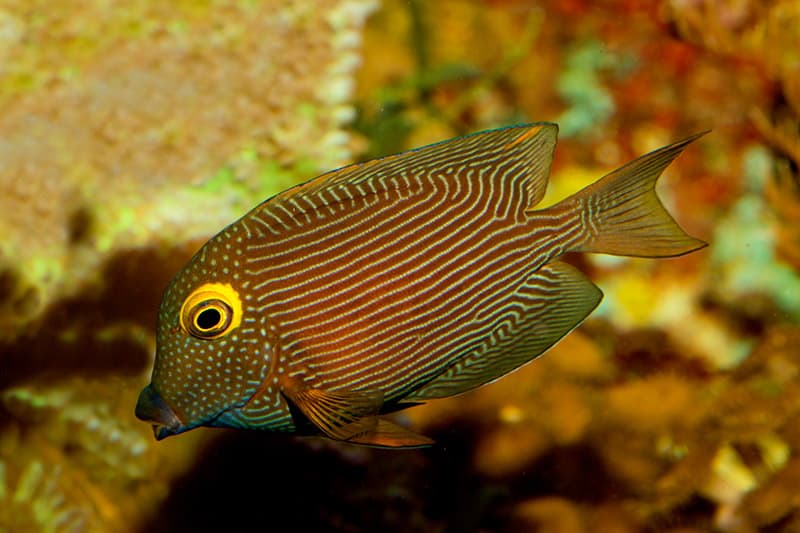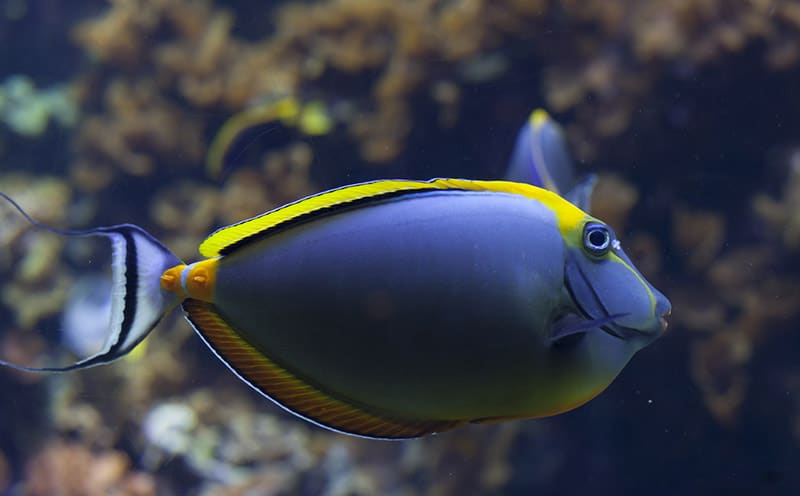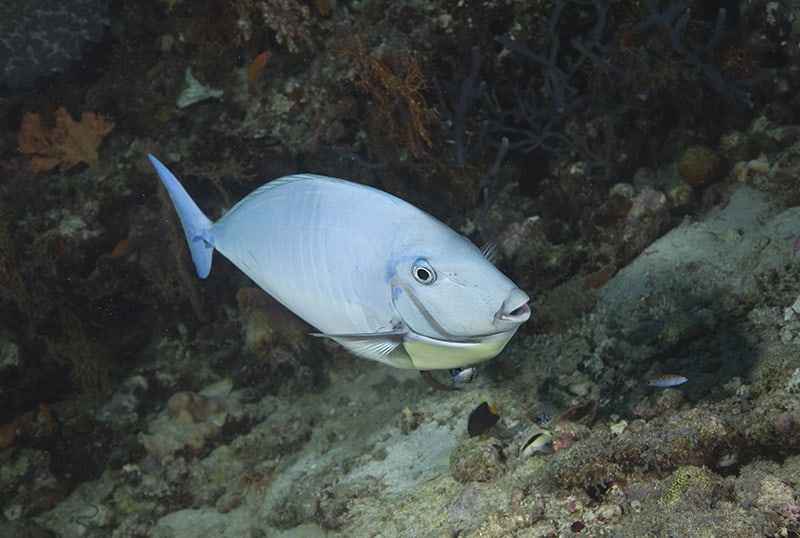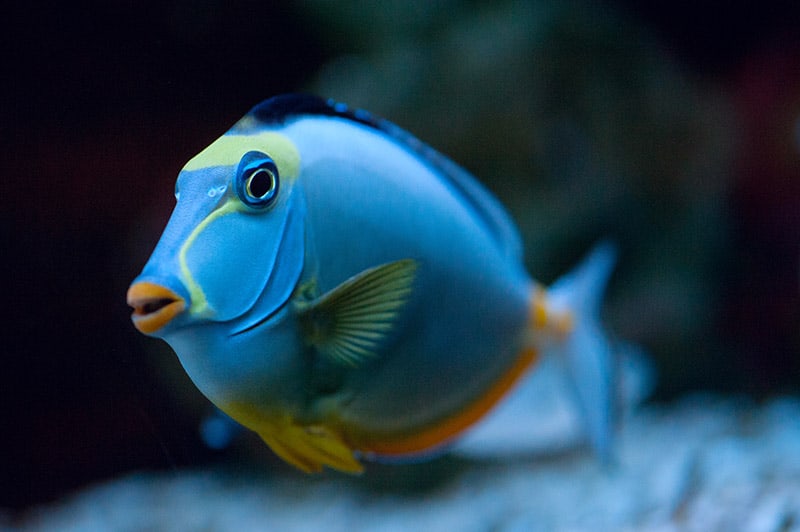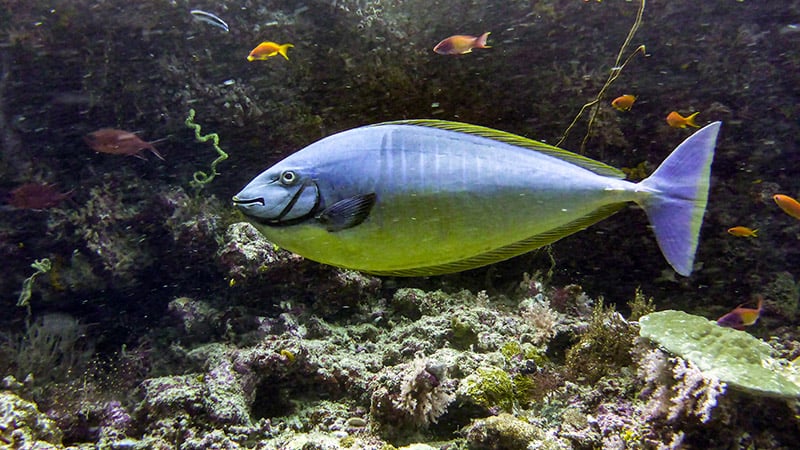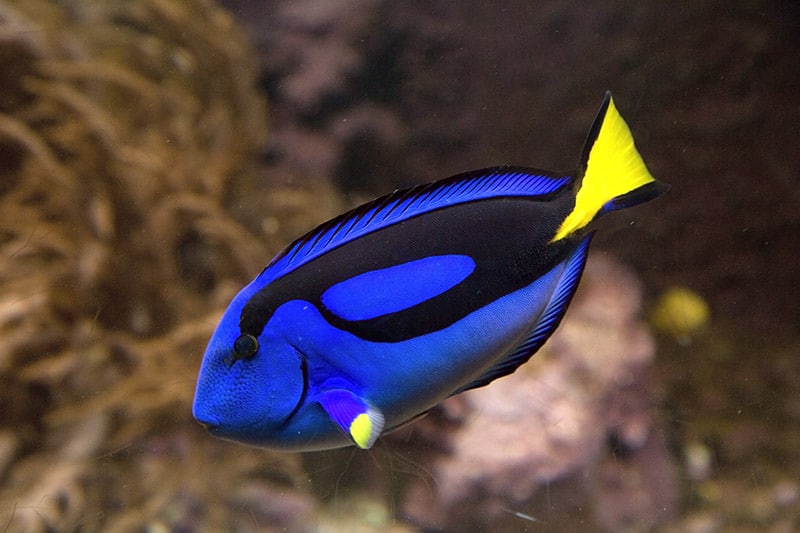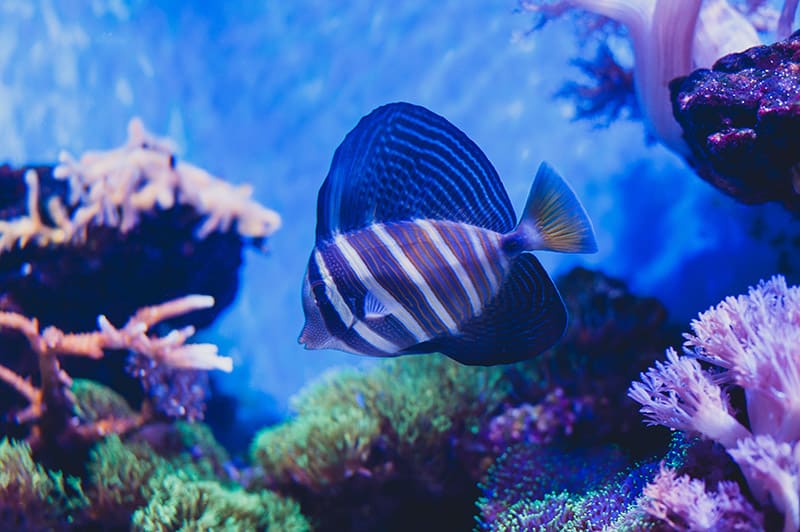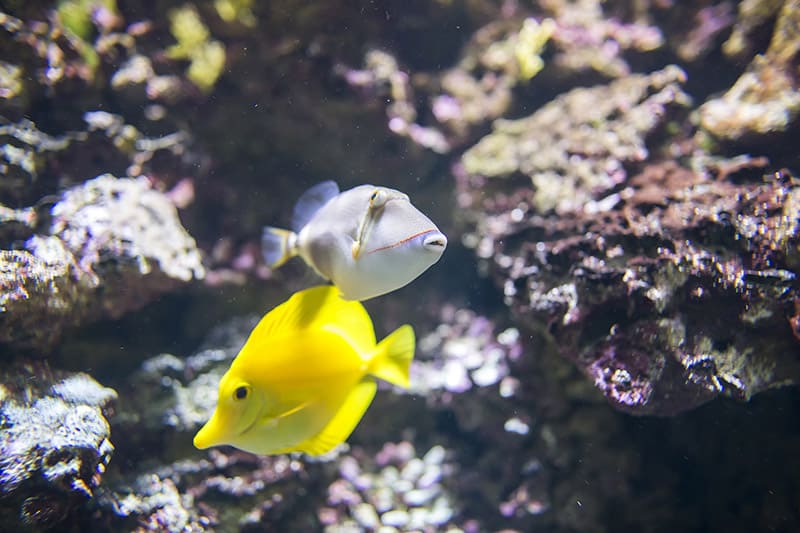Saltwater Tangs are hardy in the aquarium and can make excellent algae eaters for a reef!
The Surgeonfish, also known as Tangs, Unicornfish, and Doctorfish, are members of the Acanthuridae family. This is an ancient family that has endured for more than 50 million years. In the aquarium they are very durable, some would even say the proverbial “tough as nails!”
Saltwater tangs range in size from just a few inches to a some of the largest, such as the Whitemargin Unicornfish Naso annulatus, that reaches almost 40 inches (100 cm) in length. Thus many make very fine specimens for the home aquarium but some are really only suitable for public aquariums. Surgeonfish have oval bodies that are very compressed laterally and small mouths adapted for nibbling and scraping small organisms from the rocks and coral.
The name “surgeonfish” is derived from their possessing erectable razor sharp spines. These ‘scalpels’ are located at the base of their bodies just in front of the tail fin. Tangs are quick and swim in a graceful fashion, dipping in and out of the decor, nibbling on tiny morsels of algae. But sometimes they can be territorial. Their spines are very sharp and can cut like a knife, and these razor-wielding fish are very skilled with their swords. With a quick twist of their tail these swords become formidable weapons.
Tangs are often good community fish, great in a reef, and most varieties of Surgeonfish can be kept together. These fish quickly become familiar with their home and keeper, coming forward for foods and some has even been trained to allow a bit of petting. Just be very careful when cleaning the tank, and especially when the need arises to capture/net them.
The list of saltwater tangs below includes many aquarium species. Each fish guide has pictures to help with saltwater fish identification, along with in-depth surgeonfish information. Read about each species to learn about its size, adaptability, behavior, diet, and especially compatibility with its own species as well as any other species to aid in choosing your pet fish.
- For setting up a saltwater aquarium, see: Marine Aquarium Basics: Guide to a Healthy Saltwater Aquarium
Genus: Zebrasoma – Sailfin Tangs
Sailfin Tang
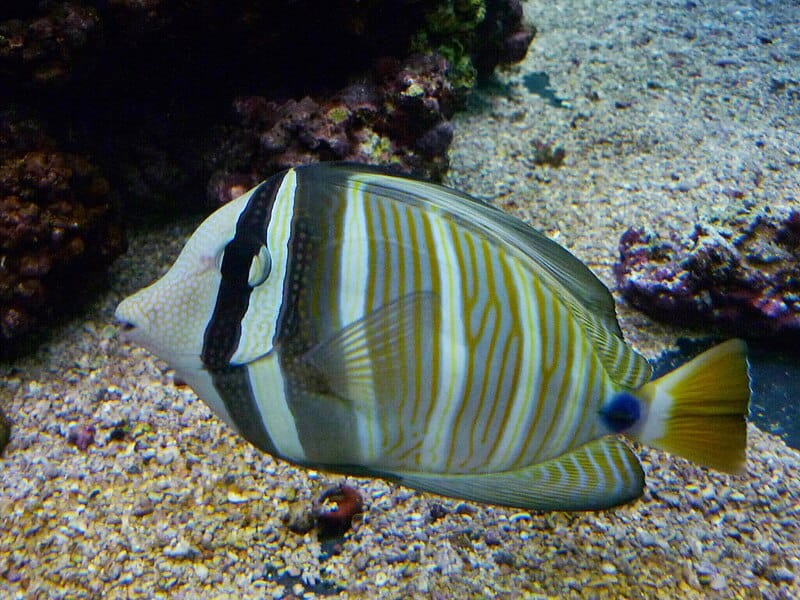
Zebrasoma veliferum
Surgeonfish Facts
The surgeonfish belong to the Acanthuridae family. They are a very ancient fish, with fossils dating back more than 50 million years to the Tertiary period (Eocene). These species are clearly distinguished from other fish by the spine or spines located on each side of the caudal peduncle, the base of the tail fin. These spines are either foldable or fixed. They are blade like and quite sharp, similar to a scalpel.
As a group they are all known as Surgeonfish and Saltwater Tangs. The name ‘surgeonfish‘ is derived from their unique scalpel-like spines. The name ‘tang‘ is derived from the German word ‘Seetang’ which means ‘seaweed’ and relates to their feeding habits. But several different groups within this family are also known as Unicornfish, Sailfin Tangs, and Bristletooth or Combtooth Tangs.
The popular ‘unicornfish‘ are from the Naso genus. They are called the Unicornfish because some of the species have a horn-like projection on the forehead. The term ‘sailfin tang‘ is most often applied to the popular species in the Zebrasoma genus. The Ctenochaetus genus are often referred to as ‘bristletooth‘ or ‘combtooth‘ tangs, due to their nature of feeding. Atlantic species from both the Acanthurus and Prionurus genera are sometimes referred to as ‘doctorfish‘ tangs.
Surgeonfish Habitat
Saltwater tangs are found in all the tropical seas of the world, with the exception of the Mediterranean. Most are found in relatively shallow waters, especially where the water is clear and the rock, rubble, or dead coral is exposed to good sunlight providing good algae growth. Coastal waters, harbors and even estuaries for the young are prime areas for these fish. Many of these surgeonfish are small enough for a home aquarium.
Species that inhabit the open ocean are fewer, but are found in larger numbers. Most of these surgeonfish get quite large with some species reaching up to almost 40 inches (101 cm). These larger fish are not suitable for a home aquarium but will often be featured in public aquariums.
Surgeonfish usually live in large schools or in pairs. They primarily ingest plant matter with most grazing on the reef, but will also pick at the detritus, and there are some that feed predominantly on zooplankton. At night they sleep in small caves or crevices in the reef.
Species of Surgeonfish
The Acanthuridae family of surgeonfish consists of 6 genera and about 82 species. Most species are relatively small reaching between 6 to 16 inches (15 – 40 cm) in length. (15 – 40 cm), but some species in the Acanthurus, Prionurus, Naso genera can grow larger. One of the largest of this family is the Whitemargin Unicornfish Naso annulatus, that reaches 39.4 (100 cm) in length. The spines on the caudal are the distinguishing characteristics that Ichthyologists use to place each member into their appropriate sub-family and tribe.
Acanthuridae family classification. In the current classification scheme this family is divided into two subfamilies: Subfamily Acanthurinae, which is split into three tribes, and the Subfamily Nasinae.
|
Tang Aquarium Species
Saltwater Tangs are curious, active, and very personable fish. They make good aquarium inhabitants as they are peaceful and get along well with a wide variety of other fish. They are also voracious algae eaters, making them excellent candidates for a reef environment.
Many of the relatively small surgeonfish are among the hardiest of the marine aquarium fish. There are five main genera of Surgeonfish suitable for the aquarium. The Prionurus genus is the only one of the six that is rarely available for home aquariums.
- Acanthurus – The genus Acanthurus currently consists of 38 known species, which is close to half of the Surgeonfish species. This genus has the largest number of species of all six genus in the Acanthuridae family, and they are found in all three oceans. Many of these species are very colorful, making them popular aquarium inhabitants.
- Ctenochaetus – The genus Ctenochaetus consists of 9 species. They are often referred to as the ‘Bristletooth’ or ‘Combtooth’ Tangs, due to their nature of feeding. They have several rows of small flexible comb like teeth (up to 30 teeth) along with a protrusive pouting mouth. These teeth are adapted for lifting and sifting through various types of algae and detrital material off of rocks, sand, and other surfaces and then they use their mouth to suck the food up.
In the aquarium you will often see little lip marks on the glass where algae used to be from this feeding behavior. Unlike most of the other tangs of the Acanthuridae family who posses 9 dorsal spines, the Ctenochaetus have only 8 dorsal spines (the first one being very small).
The most popular and available species in this genus are the Yellow-eyed Tang Ctenochaetus strigosus and the Chevron Tang Ctenochaetus hawaiiensis. Their diet makes each a great complimentary companion for other peaceful surgeonfish such as those in the Zebrasoma genus that eat the larger filamentatous algae. Several species in the genus Ctenochaetus exhibit a change in coloration from juvenile to adult, though most other surgeonfish don’t change color as they get older.
- Naso – The genus Naso consists of 20 species. The most popular characteristic of this genus is the development of a lump or single horn-like projection on the forehead of some of the members of the Naso genus, giving them the designation of ‘Unicornfish’. However many of them don’t develop horns at all, and some only develop horns on the male fish.
Other characteristics include an elongated body shape, a narrower caudal peduncle with two scalpels or spines on either side that are fixed rather than retractible (with the exception of three species having only a single spine), three pelvic fin rays, and a single continous dorsal fin starting at the head and extending the length of the body.
These fish generally swim in large schools and feed on zooplankton. The exception is Naso literatus, the “Lipstick Tang“, which feeds on algae and usually lives in pairs. They are among some of the hardiest and most peaceful of the surgeonfish, the biggest obstacle to maintaining them in an aquarium is their very large size, ranging from one to over three feet. Most are suitable only for a public aquariums. The Lipstick Tang N. literatus is again the exception, as it can fit in quite well in a large home aquarium.
- Paracanthurus – There is only one species in the genus Paracanthurus, and it is probably the most popular of the tangs. It is the Blue Tang Paracanthurus hepatus, also known as the Regal Tang or Hippo Tang.
- Zebrasoma – The genus Zebrasoma consists of 7 species. They are popularly called the ‘sailfin tangs’ because when their fins are fully extended the height of the fish is about the same as its length, giving it a disk-shaped appearance. The sailfin tangs are found in every ocean of the world.
These relatively small surgeonfish are the hardiest of the marine aquarium inhabitants. They make good aquarium inhabitants as they are peaceful and get along well with a wide variety of other fish. They are curious, active, and very personable; and they are voracious algae eaters making them excellent candidates for a reef environment. Some favorites that are regularly available are the Yellow Tang Zebrasoma flavescens, Pacific Sailfin Tang Zebrasoma veliferum, and the Twotone Tang Zebrasoma scopas.
Tang Fish Care
Many of the surgeonfish can be robust aquarium inhabitants in a proper environment that is well maintained. The individual species of surgeonfish vary somewhat in their care requirements and hardiness, but most need large quantities of algae and other plant material. They also need a large sized aquarium with suitable decor for hiding places, but that also has lots of open swimming space along with a brisk current and well oxygenated water.
The water quality needs to be pristine and stable. Although Surgeonfishes can be quite durable they are very prone to skin diseases, typically Marine Ich Cryptocaryon irritans and Marine Velvet Oodinium ocellatum. They will succumb to illness quickly in a less than optimal environment. These fish eat a lot and produce a lot of waste, so the addition of a protein skimmer is a must.
Saltwater Tangs are an especially great addition to a reef where they will continually graze on algae growth. Just keep an eye, as certain species may have an appetite for sessile invertebrates, like large-polyped stony corals. This behavior usually starts when grazing for feces, but some tangs then begin to nip the mouth and polyps of the coral itself. Most make good tank mates in a community setting too, however they will not tolerate their own kind and are very often belligerent with other tang species. It’s best to keep just one tang per tank, unless the tank is very large and you are an experienced aquarist. Tangs are often aggressive towards other herbivores added after they are established.
Due to their scalpel-like spines, you need to be very careful when handling these fish to avoid a painful cut. A cut from these spines can cause discoloration and swelling of the skin with a high risk of infection. The pain lasts for hours then still ends up having a dull ache. It is a good idea to use a fine meshed net when catching them to keep them from getting stuck in the net.
They should be fed several times a day. In the wild, algae are their main food source and they are continually browsing. They should primarily be offered a vegetable based diet at least three times a day. Provide prepared herbivores foods and dried or frozen marine algae, even some broccoli on occasion. The dried macroalgae, Japanese Nori, is especially enjoyed and Romaine lettuce or spinach can be floated in the aquarium for grazing. They will also need some meaty foods, especially as juveniles to add bulk. Meaty foods include brine shrimp, blood worms, chopped clams, plankton, and krill.
Featured Image Credit: neelsky, Shutterstock
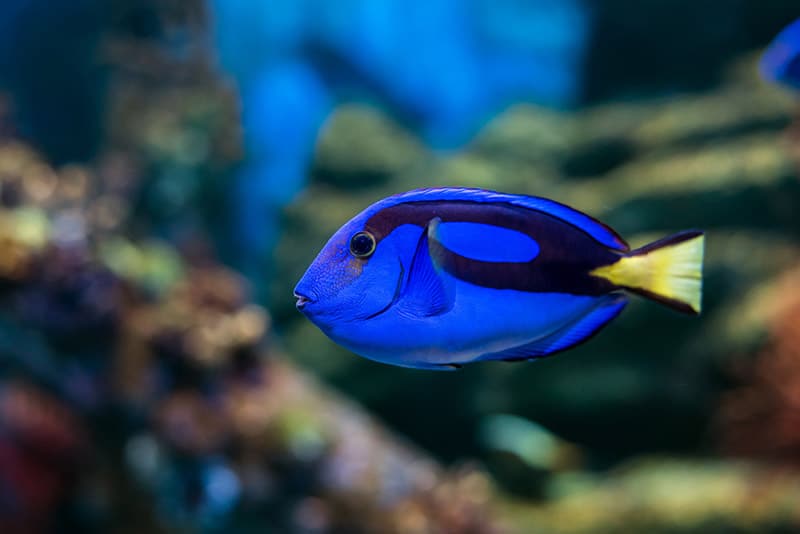
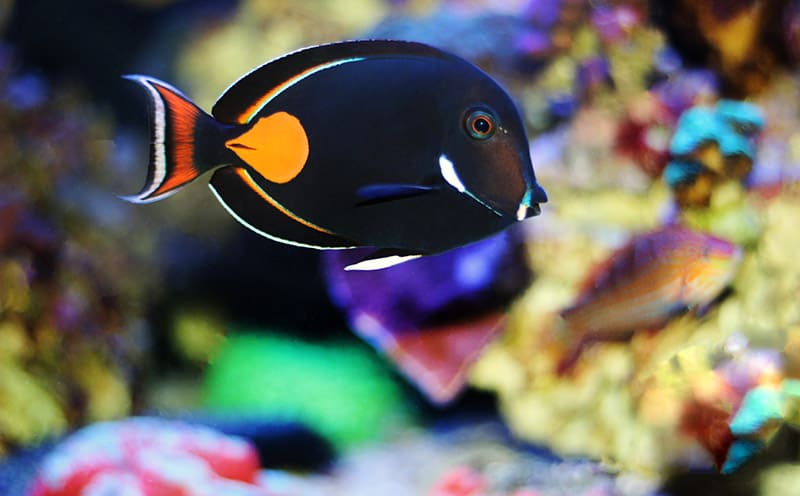

SurgeonfishWMTa_Cx0690_vsm.jpg)
TangWMTa_Ap8ST_vsm.jpg)
TangWMTa_Ap8ST_vsm.jpg)



SurgeonfishWMTa_Ap8ST_vsm.jpg)
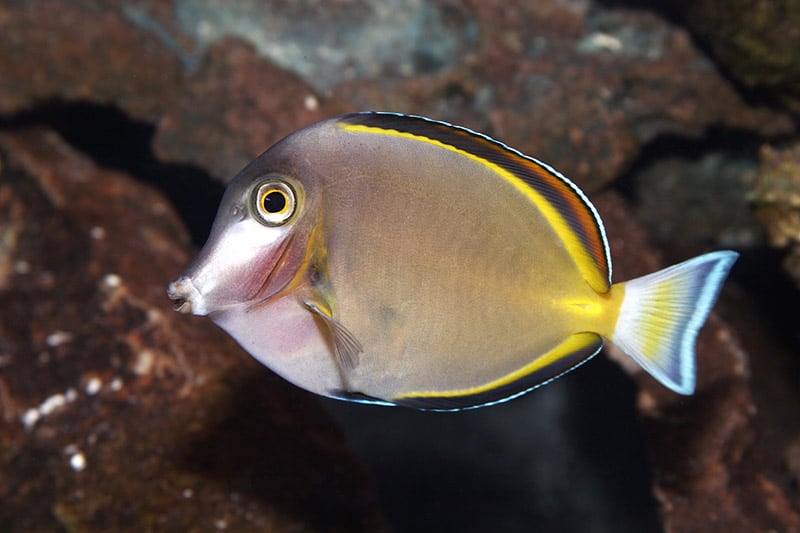



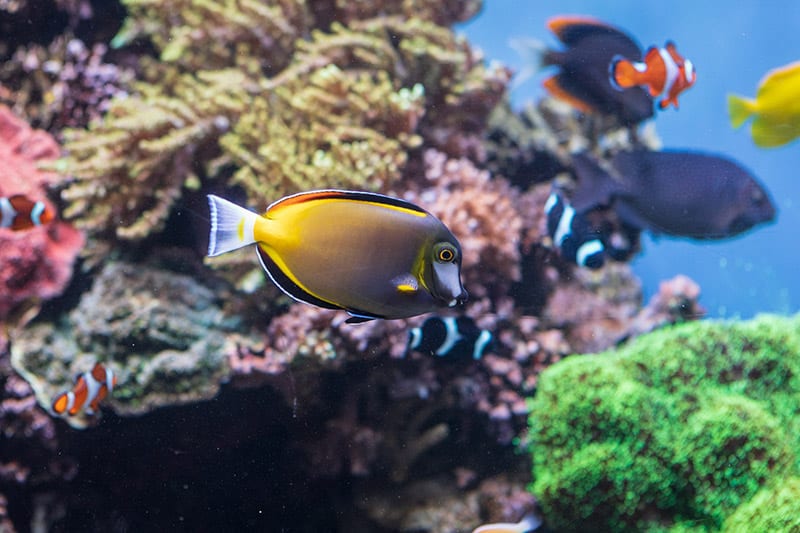



TangWMTa_Ap8ST_vsm.jpg)
